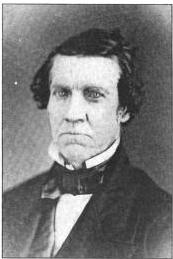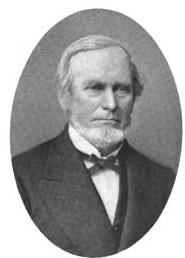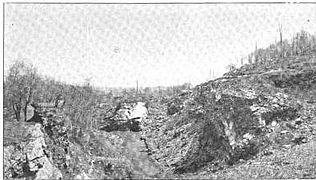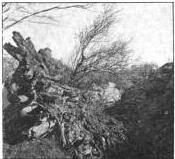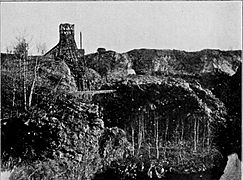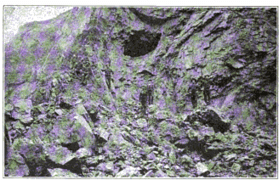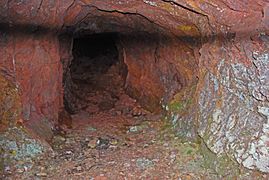Jackson Mine facts for kids
|
Jackson Mine
|
|
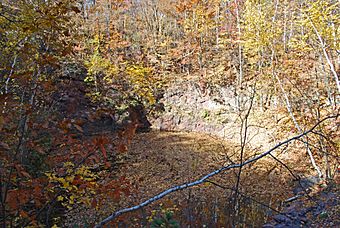
North Jackson Pit No. 1, 2010
|
|
| Nearest city | Negaunee, Michigan |
|---|---|
| Area | 1 acre (0.40 ha) |
| Built | 1848 |
| NRHP reference No. | 71000414 |
Quick facts for kids Significant dates |
|
| Added to NRHP | September 03, 1971 |
The Jackson Mine is an open pit iron mine located in Negaunee, Michigan. It was the very first iron mine in the Lake Superior area. This mine helped start the economy of the entire region.
The Jackson Mine was named a Michigan State Historic Site in 1956. Later, in 1971, it was added to the National Register of Historic Places. People say the mine is special because it's where iron ore was first found, first mined, and first used to make iron in the Lake Superior region. You can find the mine northwest of where Business M-28 and Cornish Town Road meet.
Contents
How the Jackson Mine Started (1844–1847)
In 1844, a government surveyor named William A. Burt was exploring Michigan's Upper Peninsula. On September 19, 1844, Burt noticed his compass acting strangely near Teal Lake. He asked his team to check it out.
They found rocks that contained iron ore. This area later became known as the Marquette Iron Range. Local Ojibwe people (also called Chippewa) and other Native Americans already knew about these iron deposits. However, Burt and his boss, Douglass Houghton, were the first to tell the wider world about this discovery.
Forming the Jackson Mining Company
In June 1845, a group of business people in Jackson, Michigan, started the Jackson Mining Company. They first wanted to mine copper in the Upper Peninsula. They sent a team, led by Philo M. Everett, to find copper.
When Everett's team arrived in Sault Ste Marie, they met Louis Nolan. Nolan was a French Canadian who knew about Burt's iron discovery. Everett became interested in the iron instead of copper. Nolan guided the team to the Carp River and then to Teal Lake.
The team then met Chippewa chief Marji-Gesick. He knew the Teal Lake area well. Marji-Gesick showed Everett iron ore in the roots of a fallen tree. This is where the Jackson Mine was later built. The tree stump was kept for its history until it burned in 1900. Even so, the tree is still a symbol on the city of Negaunee's official seal.
Everett claimed the site and had the ore tested. It was high-quality iron ore, mostly hematite. Because of this, the Jackson Mining Company decided to focus on iron instead of copper.
Early Mining and Iron Production
In 1846, the company sent another group to explore the area more and get more ore for testing. They successfully turned the ore into iron. In the winter of 1846–1847, the Jackson Mining Company brought equipment to the mine.
In 1847, they started digging ore out of the mine. They also began building the Carp River Forge, a place to melt and shape iron. The forge was finished the next year. The first pieces of iron from the Jackson Mine were made at the Carp River Forge. They were then sold to help build a steamboat.
The Jackson Iron Company Grows (1848–1870s)
In 1848, the Jackson Mining Company changed its name and leadership. Most of the first investors, like Philo Everett, lost control. In 1849, the company got a new president, Ezra Jones, and a new name: the Jackson Iron Company.
By 1850, the company faced many problems. They stopped using their forge on the Carp River and rented it out. The company was in financial trouble and even stopped mining for a while. However, mining soon started again, but the forge stayed closed.
The Jackson Company began using the Marquette forge instead. They also started shipping some iron ore directly. The first shipment of five tons went to New Castle, Pennsylvania. This pure ore got a lot of attention. General Joel B. Curtis, who led the Sharon Iron Company in Sharon, Pennsylvania, came to see the mine. He liked it so much that he bought a controlling share of the Jackson Iron Company. For some years, the Jackson mine was even called "the Sharon."
Negaunee: A Town is Born
With Curtis's help, the company shipped more ore. In 1852, 70 tons went to Sharon Iron. But shipping ore was still hard. So, in 1857, the Jackson Mine started building its own furnace right at the mine site.
More workers came as mining grew and the furnace was built. A town quickly grew around the mine and furnace. In 1857, this town was officially named "Negaunee." This name comes from an Ojibwa phrase meaning "I take the lead" or "pioneer."
For some years, the Jackson Mine was not run very well and had money problems. But in 1861, the management became stable. During the Civil War, there was a high demand for iron. This helped the Jackson Iron Company make its first profit in 1862.
The Jackson Mine increased its production, reaching its highest levels in the late 1860s and early 1870s. The year 1871 was when they produced the most iron. The company also built an iron furnace at Fayette in 1867. By 1875, the mine had produced over 1.5 million tons of iron ore!
- Mine Images, c. 1900
Mine's End and Legacy (1870s–Present)
After the 1870s, the price of iron ore went down. Still, by 1900, the Jackson Mine had produced over 3.6 million tons of iron ore. But the company was struggling financially because of the lower prices and uneven deposits of ore. In 1904, the Jackson Mine didn't produce any ore at all.
The mine got a new chance in 1905 when the Cleveland-Cliffs Company bought the Jackson Iron Company. But the mine still didn't produce much. It produced no ore in 1908 and again in 1916. The Jackson Mine finally closed for good in 1924. Since it opened, it had produced over 4 million tons of ore.
What Remains Today
When it closed, the Jackson Mine had several working pits, test shafts, a forge, and underground tunnels. Some of these underground areas were close to the surface. In the 1950s, parts of the Jackson Mine and the town of Negaunee were closed. This was because people worried the ground might collapse due to the old mining tunnels.
Because of its important history as the first iron mine in the area, the site was named a Michigan State Historic Site in 1956. It was then added to the National Register of Historic Places in 1971.
In 2003, the city of Negaunee took over the mine and the land around it. They checked the danger of collapse again. In 2006, much of "West Old Town Negaunee" and areas near the mine were reopened to the public. The city created a system of trails through the area. You can now see the overgrown ruins of the old Jackson Mine pits from these trails.
- Mine Images
-
A drift (tunnel) opening near North Jackson Pit No. 1, 2010
Jackson Park
South of the Jackson Mine site is Jackson Park. This park is about 5 acres (2.0 ha) in size. It's located next to Business M-28 southwest of downtown Negaunee. The park has two tennis courts and four horseshoe courts for people to enjoy. Before the ground sank from mining activities, the park was much larger, about 11.8 acres (4.8 ha), and even offered campsites for visitors.



